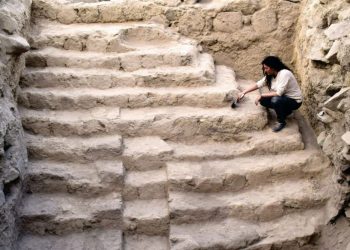A remarkable archaeological discovery in Denmark has revealed a Roman warrior’s treasure trove buried over 1,600 years ago, including fragments of a rare helmet, chainmail, and nearly 200 weapons. Experts believe this find could be linked to a mysterious ritual connected to the construction and demolition of homes.
During a highway expansion project near Løsning Søndermark, between Vejle and Horsens, archaeologists unearthed an astonishing Iron Age cache buried within the foundations of two ancient structures. The discovery included a rare Roman helmet, chainmail armor, and an arsenal of weapons—swords, spears, lances, and horse equipment. This suggests the presence of a Roman-era warrior in southern Scandinavia, an unusual occurrence for the time.
The artifacts were carefully placed in holes left by load-bearing posts, indicating a ritual offering rather than a simple weapons cache. According to Vejle Museum researchers, this points to a ceremonial act performed during the demolition and construction of homes.
A Helmet Unlike Any Other
At first glance, two small iron plates, each no larger than a human palm, seemed like nothing special. But once archaeologists put them through X-ray imaging, the truth emerged—they were fragments of a rare Roman crest helmet dating back to the fourth century. One piece turned out to be a decorated cheek guard, while the other was a protective neck guard, both belonging to a type of helmet once worn by Rome’s elite warriors.
“Roman helmet finds from the Iron Age are exceptionally rare in southern Scandinavia, and there are no direct parallels to this discovery,” the museum confirmed, highlighting its unprecedented significance in Denmark.
Elite Warrior’s Armor
The site also yielded a remarkably well-preserved chainmail shirt—an item typically reserved for high-ranking individuals due to its costly production. Unlike previous finds in Scandinavia, which were recovered from burial sites or bog deposits, this chainmail was found within a settlement, adding to the mystery of its origin.
Alongside the armor, researchers found fragments of two bronze neck rings, similar to those worn by Iron Age chieftains. These personal adornments further suggest that the buried weapons and armor belonged to an elite warrior or leader.
A Ritualistic Burial
The placement of nearly 200 weapons in separate structures suggests a connection to ritualistic practices. One set of weapons was buried within the remains of a demolished house, while the other was tightly packed around the posts of a newly constructed home.
“The nature of these deposits suggests that the weapons were part of ceremonies or sacrificial rituals associated with a chieftain’s residence,” the researchers explained in the statement. “This indicates that they are not remnants of a weapons workshop, military barracks, or similar contexts.”
Further analysis of the materials will help determine whether the buried equipment belonged to local warriors or if it was taken as spoils of war from a defeated enemy. Either way, this discovery sheds new light on the complex interactions between Roman and Iron Age societies in Scandinavia.











